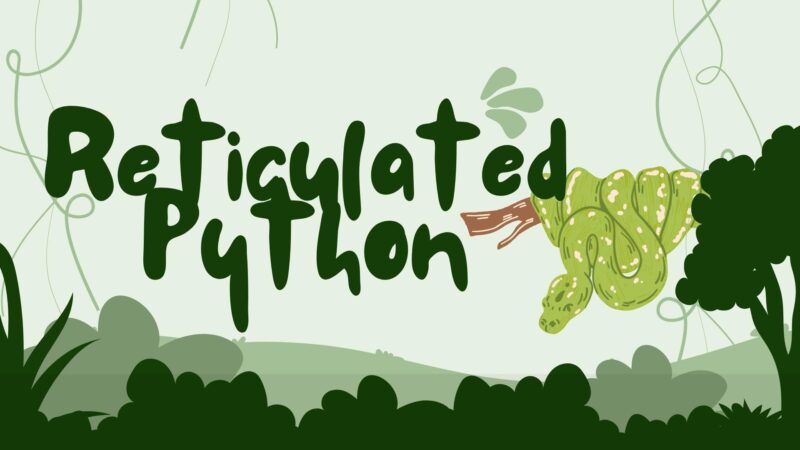Welcome to the captivating world of Reticulated Python! 🌏 In this educational blog post, we will delve into the amazing facts about one of the most remarkable and largest snake species on Earth. The Reticulated Python (Python reticulatus) is a fascinating reptile that captures the imagination of both nature enthusiasts and herpetology lovers alike.
From their incredible size and impressive hunting skills to their unique characteristics and conservation status, these majestic serpents have much to offer. So, let’s embark on a thrilling journey to discover 10 captivating Reticulated Python facts!
🔎1: Magnificent Size and Length 📏
The Reticulated Python is truly a titan among snakes, with the ability to reach astonishing lengths! 📏 In fact, they are considered the longest snake species in the world. Specimens have been recorded at lengths exceeding 30 feet (9 meters) 🐍, making them awe-inspiring giants of the reptile realm.
These colossal dimensions are a testament to their adaptability and survival prowess, enabling them to thrive in a variety of environments. The Reticulated Python’s lengthy body serves as both a remarkable hunting tool and an efficient means of moving through their dense tropical habitats with ease.
🔎2: Gorgeous Reticle Patterns 🐾
One of the defining features of Reticulated Python is its beautiful reticle patterns, from which it gets its name. The intricate net-like patterns that cover their skin give them a striking appearance 🎨, making them the fashionistas of the snake world.
Each Reticulated Python boasts a unique pattern, akin to an artistic masterpiece created by nature itself. These stunning patterns come in a range of colors, from earthy browns and rich blacks to vibrant oranges and yellows. It is believed that these patterns not only enhance their beauty but also serve as a means of individual identification.
Moreover, these reticle patterns play a critical role in their survival. They act as a natural camouflage, allowing Reticulated Pythons to blend seamlessly into their forested habitats. By remaining virtually invisible to unsuspecting prey and potential predators, they can execute their hunting strategies with unrivaled stealth.
Discover the captivating world of the Lone Star’s serpentine wonder, the Texas rat snake, and learn more about its facts, diet, and habitat in this article.
🔎3: Masterful Predators 🎯

As skilled predators, Reticulated Pythons employ a patient and stealthy hunting strategy. They are constrictors, using their powerful muscles to subdue prey before swallowing them whole. Prey can range from small mammals to birds, and on occasion, even larger animals such as deer 🦌.
The Reticulated Python’s predatory technique is nothing short of impressive. When hunting, they rely on their keen senses and ability to detect the faintest heat signatures emitted by their warm-blooded victims. Once prey is located, these serpents strike with lightning speed, wrapping their muscular coils around the unfortunate creature.
This lethal embrace constricts the prey, leading to asphyxiation. The python then proceeds to swallow its meal whole, aided by flexible jaws that can stretch to accommodate prey much larger than its head. Such mastery in hunting has earned the Reticulated Python a fearsome reputation among the creatures that share their native habitats.
🔎4: Notorious Ambush 🌳
Reticulated Pythons are masters of camouflage and ambush. They patiently lie in wait, coiled and hidden among foliage, until unsuspecting prey wanders close enough 🌿.
This hunting strategy is a testament to their remarkable intelligence and adaptability. By utilizing their exquisite reticle patterns and natural coloration, they become virtually invisible among the leaves and branches of the dense forests they inhabit. Such stealthy prowess allows them to surprise and overwhelm their prey with swift, decisive strikes.
Upon detecting vibrations or heat signatures of nearby prey, the python springs into action. With incredible speed, they seize their target and coil around it, ensnaring it in a vice-like grip. By preventing the prey from escaping, the Reticulated Python ensures its next meal with the utmost efficiency.
🔎5: Arboreal Wonders 🌳
Unlike many other large snake species, Reticulated Pythons are excellent climbers 🧗♀️. Their prehensile tails, strong muscles, and sharp scales allow them to gracefully ascend trees with ease.
Their adaptability to both terrestrial and arboreal habitats makes them versatile hunters, expanding their potential range across Southeast Asia. In pursuit of prey, they can effortlessly transition from forest floors to tree canopies, providing them access to an abundant and diverse food supply.
By combining their climbing abilities with their stealth and hunting prowess, Reticulated Pythons have secured a formidable place as top predators in the treetops of their lush tropical homes.
🔎6: Unique Heat-Sensing Abilities 🔥

To help locate prey and navigate their environment, Reticulated Pythons possess specialized heat-sensing organs known as “pit organs” on their upper and lower lips. These organs allow them to detect the infrared radiation emitted by warm-blooded animals, giving them a distinct advantage during nighttime hunts 🌙.
Imagine seeing the world through infrared vision! With this remarkable ability, Reticulated Pythons can effectively “see” in total darkness, allowing them to pinpoint the exact location of their prey, even in the densest of jungles. By detecting the body heat of their quarry, they ensure greater hunting success, especially during the cover of the night.
Such an extraordinary adaptation has played a crucial role in the python’s evolution as a successful predator, aiding them in capturing prey and navigating their environment with unparalleled precision.
🔎7: Lengthy Digestion Process ⏳
After a hearty meal, Reticulated Pythons embark on an extended period of digestion that can last several weeks or even months! During this time, their metabolic rate increases drastically, aiding in the breakdown of the large meal.
This prolonged digestive process is an essential adaptation for surviving in environments where prey may be scarce and unpredictable. By maximizing the energy obtained from each meal, Reticulated Pythons can endure long periods without eating, allowing them to wait patiently for the opportune moment to strike again.
Such an extraordinary feat of digestion showcases the python’s ability to adapt and thrive in challenging ecosystems, where food availability can be scarce and sporadic.
🔎8: Fascinating Reproduction 🥚
The Reticulated Python’s reproductive process is a marvel in itself. Females lay clutches of eggs, which they coil around and incubate to maintain an optimal temperature 🌡️.
This maternal dedication is nothing short of awe-inspiring. The female python assumes the responsibility of ensuring the survival of her offspring from the moment the eggs are laid. By coiling around the clutch, she creates a protective barrier, shielding the eggs from predators and environmental fluctuations.
During incubation, the female closely regulates her body temperature, ensuring that the developing embryos receive the necessary warmth for proper development. Once hatched, the baby pythons are independent and must fend for themselves from the outset, venturing into the world as self-sufficient predators.
In Florida’s wilderness, it’s crucial to be aware of the most lethal serpents and how to avoid them, as detailed in the article.
🔎9: Human Interaction and Conservation 🤝
Unfortunately, the Reticulated Python faces numerous threats in the wild, including habitat loss, poaching for their skin and body parts, and the pet trade.
Conservation efforts are crucial to protect this magnificent species, and various organizations work tirelessly to safeguard their future 🌿.
The Reticulated Python plays a vital role in maintaining ecological balance within its habitat. By controlling populations of prey species, these magnificent serpents contribute to the health and stability of their ecosystems. Additionally, they hold cultural significance in many communities, often revered as symbols of strength and wisdom.
Through public awareness, habitat preservation, and sustainable practices, we can secure a promising future for the Reticulated Python and protect the fragile ecosystems they call home.
🔎10: Awe-Inspiring Species for Education 🎓

The Reticulated Python serves as an incredible ambassador for wildlife education. Learning about these majestic reptiles can inspire curiosity
FAQs:
Are Reticulated Pythons endangered?
Reticulated Pythons are not currently classified as endangered, but they face threats due to habitat loss and human activities.
Do Reticulated Pythons make good pets?
Reticulated Pythons are not suitable pets for the average person due to their size and specific care requirements. They should be kept by experienced reptile enthusiasts only.
How long do Reticulated Pythons live in the wild?
In the wild, Reticulated Pythons can live up to 20-25 years, depending on various environmental factors and survival challenges.
Are Reticulated Pythons solitary animals?
Yes, Reticulated Pythons are generally solitary creatures, only coming together during the breeding season.
How can I help conserve Reticulated Pythons and their habitats?
You can support conservation efforts by spreading awareness, supporting reputable organizations, and advocating for sustainable practices.
Can Reticulated Pythons be found in captivity?
Yes, Reticulated Pythons can be found in some zoos and wildlife sanctuaries where they contribute to educational programs and breeding initiatives.
Are there different subspecies of Reticulated Pythons?
Reticulated Pythons have a wide distribution across Southeast Asia, and there may be regional variations, but no distinct subspecies are currently recognized.
Do Reticulated Pythons have predators other than humans?
Adult Reticulated Pythons have few natural predators, but they may occasionally face competition or predation from large carnivores like tigers or crocodiles.
Conclusion:
We hope this journey into the world of Reticulated Python facts has left you in awe of these majestic serpents! 🌟 From their impressive size and striking patterns to their remarkable hunting skills and conservation status, these creatures are truly exceptional.
By spreading knowledge and fostering appreciation for the Reticulated Python, we can contribute to their protection and the preservation of their habitats.
Let’s continue to marvel at the wonders of the natural world, ensuring that future generations can share in the excitement of encountering these magnificent snakes.
Together, we can make a difference and safeguard the diverse and beautiful creatures that call our planet home. 🌍🐍








